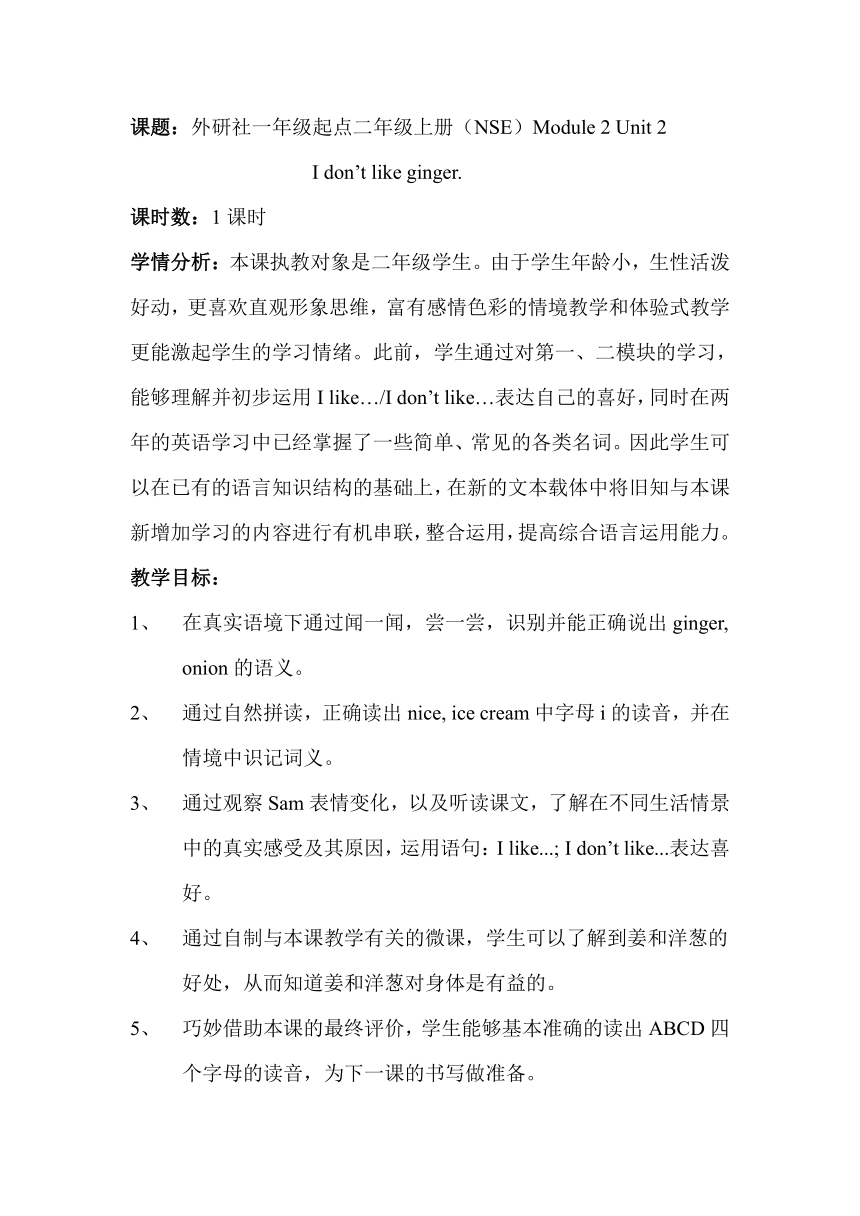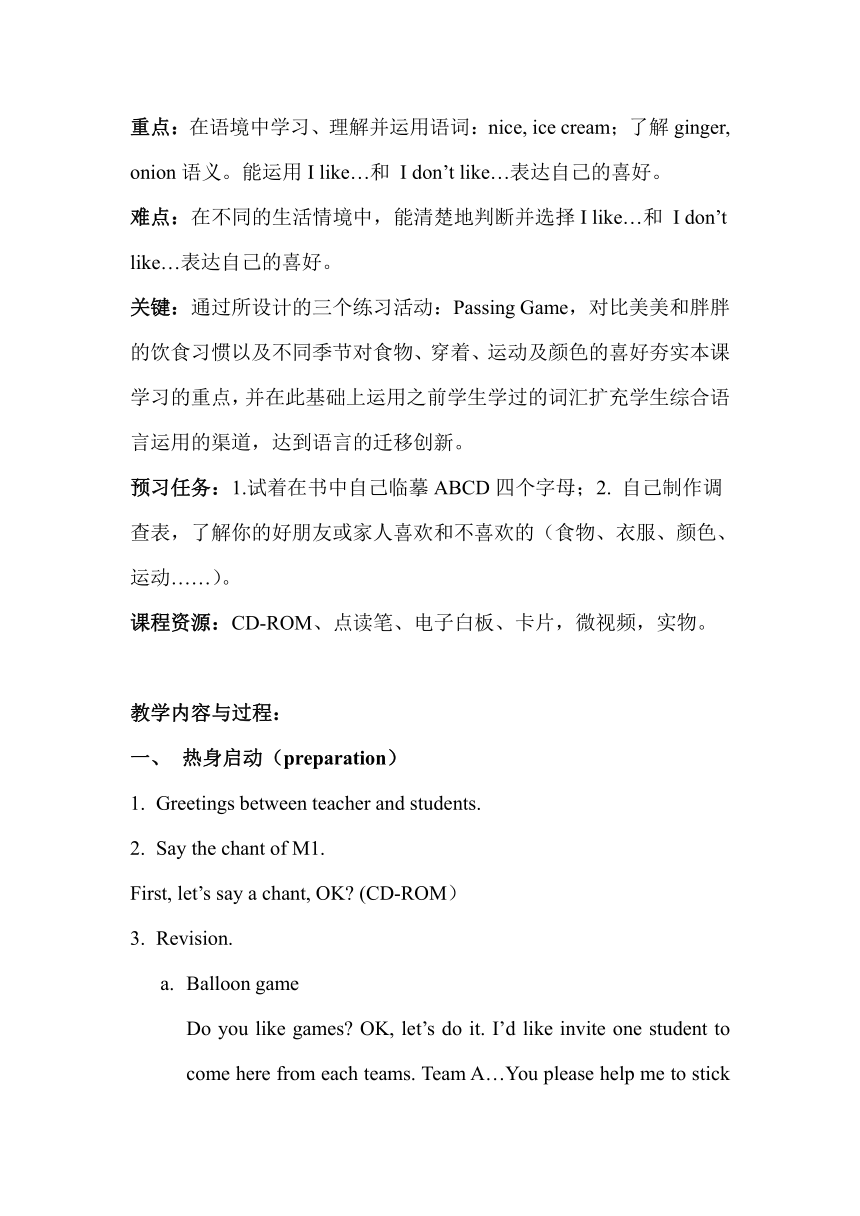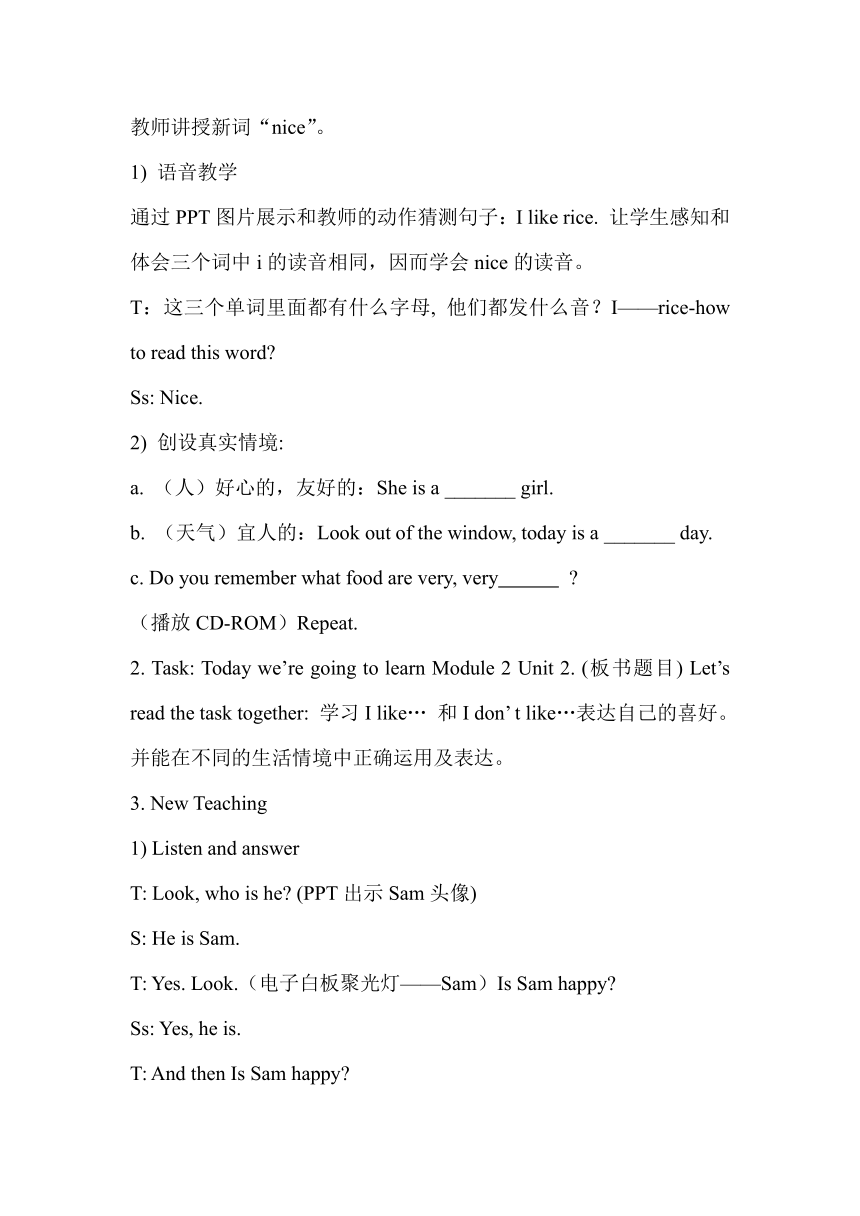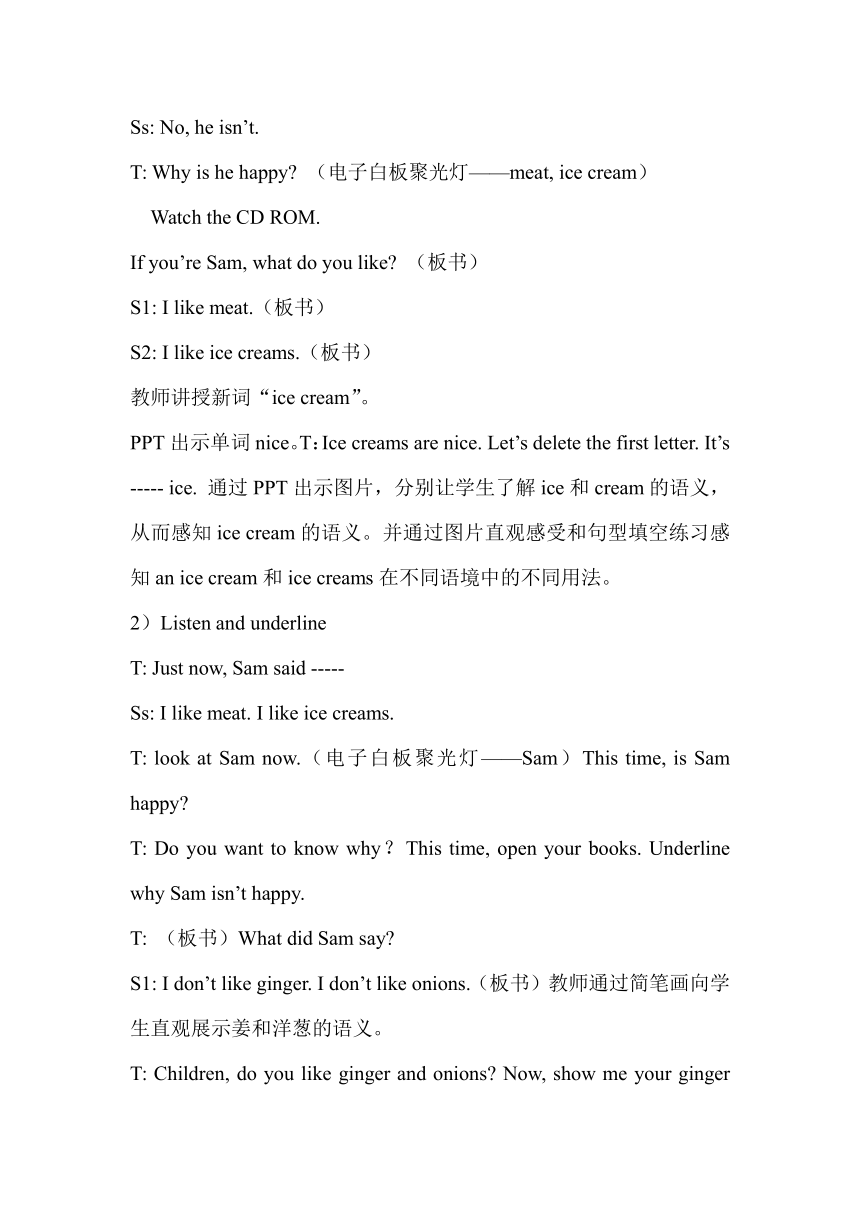Module 2 Unit 2 I don't like ginger 教案
文档属性
| 名称 | Module 2 Unit 2 I don't like ginger 教案 |

|
|
| 格式 | docx | ||
| 文件大小 | 998.2KB | ||
| 资源类型 | 教案 | ||
| 版本资源 | 外研版(一年级起点) | ||
| 科目 | 英语 | ||
| 更新时间 | 2021-09-21 18:32:13 | ||
图片预览





文档简介
课题:外研社一年级起点二年级上册(NSE)Module
2
Unit
2
I
don’t
like
ginger.
课时数:1课时
学情分析:本课执教对象是二年级学生。由于学生年龄小,生性活泼好动,更喜欢直观形象思维,富有感彩的情境教学和体验式教学更能激起学生的学习情绪。此前,学生通过对第一、二模块的学习,能够理解并初步运用I
like…/I
don’t
like…表达自己的喜好,同时在两年的英语学习中已经掌握了一些简单、常见的各类名词。因此学生可以在已有的语言知识结构的基础上,在新的文本载体中将旧知与本课新增加学习的内容进行有机串联,整合运用,提高综合语言运用能力。
教学目标:
在真实语境下通过闻一闻,尝一尝,识别并能正确说出ginger,
onion的语义。
通过自然拼读,正确读出nice,
ice
cream中字母i的读音,并在情境中识记词义。
通过观察Sam表情变化,以及听读课文,了解在不同生活情景中的真实感受及其原因,运用语句:I
like...;
I
don’t
like...表达喜好。
通过自制与本课教学有关的微课,学生可以了解到姜和洋葱的好处,从而知道姜和洋葱对身体是有益的。
巧妙借助本课的最终评价,学生能够基本准确的读出ABCD四个字母的读音,为下一课的书写做准备。
重点:在语境中学习、理解并运用语词:nice,
ice
cream;了解ginger,
onion语义。能运用I
like…和
I
don’t
like…表达自己的喜好。
难点:在不同的生活情境中,能清楚地判断并选择I
like…和
I
don’t
like…表达自己的喜好。
关键:通过所设计的三个练习活动:Passing
Game,对比美美和胖胖的饮食习惯以及不同季节对食物、穿着、运动及颜色的喜好夯实本课学习的重点,并在此基础上运用之前学生学过的词汇扩充学生综合语言运用的渠道,达到语言的迁移创新。
预习任务:1.试着在书中自己临摹ABCD四个字母;2.
自己制作调查表,了解你的好朋友或家人喜欢和不喜欢的(食物、衣服、颜色、运动……)。
课程资源:CD-ROM、点读笔、电子白板、卡片,微视频,实物。
教学内容与过程:
热身启动(preparation)
Greetings
between
teacher
and
students.
Say
the
chant
of
M1.
First,
let’s
say
a
chant,
OK?
(CD-ROM)
Revision.
Balloon
game
Do
you
like
games?
OK,
let’s
do
it.
I’d
like
invite
one
student
to
come
here
from
each
teams.
Team
A…You
please
help
me
to
stick
the
picture.
I
break
the
balloons.
You
do
actions.
And
you
say
the
sentence,
are
you
clear?
Ready?
Go!
(过程中奖励T:
Team
A…)
The
first
balloon:
I
like….
(cats,
swimming,
noodles,
dogs,
shoes)
Wow,
good
children.
Let’s
break
the
second
balloon:
I
don’t
like....
(monsters,
spiders,
snakes,
tigers,
black)
Congratulations
children.
Thank
you,
go
back
to
your
seat.
Now,
let’s
have
quickly
say.
Stand
up
and
say
“I
like
or
I
don’t
like,”
according
to
your
facts.
(
birds,
sweets,
basketball,
meat,
ABC
song,
red)
B.
Say
in
pairs.
T:
Wow,
children
you
did
the
good
job!
Look,
so
many
delicious
food
for
you.
Are
you
happy?
Now
it’s
your
turn
to
share
what
do
you
like
and
what
don’t
you
like
with
your
partner.
课文呈现(presentation)
1.
Lead-in
Just
now
you
share
what
do
you
like
with
your
partner,
do
you
know
what
does
Doris
like?
让学生先说说Look.
(电子白板画图:noodles,
rice)
S:
You
like
noodles
and
rice.
T:
Yes.
Do
you
know
why?
Let’s
watch
the
CD-ROM.
T:
Why
do
I
like
noodles
and
rice?
S:
They
are
very,
very
nice.
教师讲授新词“nice”。
1)
语音教学
通过PPT图片展示和教师的动作猜测句子:I
like
rice.
让学生感知和体会三个词中i的读音相同,因而学会nice的读音。
T:这三个单词里面都有什么字母,
他们都发什么音?I——rice-how
to
read
this
word?
Ss:
Nice.
2)
创设真实情境:
a.
(人)好心的,友好的:She
is
a
_______
girl.
b.
(天气)宜人的:Look
out
of
the
window,
today
is
a
_______
day.
c.
Do
you
remember
what
food
are
very,
very
?
(播放CD-ROM)Repeat.
2.
Task:
Today
we’re
going
to
learn
Module
2
Unit
2.
(板书题目)
Let’s
read
the
task
together:
学习I
like…
和I
don’
t
like…表达自己的喜好。并能在不同的生活情境中正确运用及表达。
3.
New
Teaching
1)
Listen
and
answer
T:
Look,
who
is
he?
(PPT出示Sam头像)
S:
He
is
Sam.
T:
Yes.
Look.(电子白板聚光灯——Sam)Is
Sam
happy?
Ss:
Yes,
he
is.
T:
And
then
Is
Sam
happy?
Ss:
No,
he
isn’t.
T:
Why
is
he
happy?
(电子白板聚光灯——meat,
ice
cream)
Watch
the
CD
ROM.
If
you’re
Sam,
what
do
you
like?
(板书)
S1:
I
like
meat.(板书)
S2:
I
like
ice
creams.(板书)
教师讲授新词“ice
cream”。
PPT出示单词nice。T:Ice
creams
are
nice.
Let’s
delete
the
first
letter.
It’s
-----
ice.
通过PPT出示图片,分别让学生了解ice和cream的语义,从而感知ice
cream的语义。并通过图片直观感受和句型填空练习感知an
ice
cream和ice
creams在不同语境中的不同用法。
2)Listen
and
underline
T:
Just
now,
Sam
said
-----
Ss:
I
like
meat.
I
like
ice
creams.
T:
look
at
Sam
now.(电子白板聚光灯——Sam)This
time,
is
Sam
happy?
T:
Do
you
want
to
know
why?This
time,
open
your
books.
Underline
why
Sam
isn’t
happy.
T:
(板书)What
did
Sam
say?
S1:
I
don’t
like
ginger.
I
don’t
like
onions.(板书)教师通过简笔画向学生直观展示姜和洋葱的语义。
T:
Children,
do
you
like
ginger
and
onions?
Now,
show
me
your
ginger
and
onions,
please.
There
are
three
steps:
1.
Smell;
2.
Lick;
3.
Eat.(choose
4
children
to
show
eating
and
talk
about
feeling)
T:
Some
children
don’t
like
ginger
and
onions.
But
they
are
good
for
you.
Let’s
enjoy
a
video.
(微视频——The
benefits
of
ginger
and
onions)
T:
Doris
wants
to
say....
From
now
on,
will
you
try
to
eat
ginger
and
onions
?(情感培养)
3)
Reading
training
a.
Listen
and
repeat跟读模仿(e-pen)
b.
read
by
yourself
自读
c.
listen
and
imitate
d.
BL:
e.
Role
play(头饰)表演
三、巩固操练(practice)
(
S1:
I
like...
Ss:
...
for
you.
S1:
Thank
you.
)1.
Passing
game.
(
S1:
I
don’t
like...
Ss:
Sorry.
)
2.
Pangpang
and
Meimei
T:
Do
you
like
making
friends?
I
have
two
friends
to
introduce
to
you----
Pangpang
and
Meimei.
T:
If
you
are
Pangpang,
what
do
you
like?
What
don’t
you
like?
(图片支撑)Talk
in
pairs.
Ss:
I’m
Pangpang.
I
like...
/
I
don’t
like...
T:
If
you
are
Meimei,
what
do
you
like?
What
don’t
you
like?
Talk
in
groups.
Ss:
I’m
Meimei.
I
like...
/
I
don’t
like...
T:
Who
do
you
like?
Because
she
has
good
habits.
四、任务完成(production)
T:
Boy
and
girls,
different
seasons,
we
have
different
habits.
For
me
:
In
summer
I
like
ice
creams
,
I
don’t
like
noodles.(此时指着PPT中的tips).
Now
let’s
discuss
different
seasons,
different
likes.
Here
are
four
parts:
food
and
fruits,
clothes,
sports
and
colour.
每个小组四个人分别选择一类来描述,Understand?
Now
let’s
talk
in
groups.
五、总结及作业(Summary
and
homework)
1.
Summary
T:
What
did
you
learn
today?
2.
课堂评价
T:
Look,
you
all
did
good
job!
Team
A
got
an
apple.
A
is
for
apple.
Team
B
got
a
bat.
B
is
for
bat.
Team
C
got
a
car.
C
is
for
car.
Team
D
got
a
dog.
D
is
for
dog.
Let’s
stand
up
and
say
this
chant.
Today’s
homework.
a、向家人或小伙伴说说你对身边东西的喜好;
b、向家人宣传姜和圆葱的好处,养成不挑食的好习惯。
六、板书设计
七、教学评价
这节课,我认为处理比较好的地方:
1、在备课之前,梳理已学过的前三册教材,对学生已学知识进行整理、归类。创设各种真实的生活情境,将新旧单词结合本课句型进行串联,真正做到知识的迁移。
2、新单词的教授上有亮点。在教授nice的时候,边做动作边分别出示I,
like,
rice这三个单词,让学生体会单词中i的读音,从而感知nice的读音,再此基础之上,通过创设真实情景,让学生了解nice除了可以表达食物的美味,还可以表达天气的晴朗和人的友好,做到了以旧带新。在单词ice
cream的教授上,通过nice感知ice中i的读音,再通过图片分别出示ice和cream的意思,了解ice
cream的语义。特别是在处理单词ginger(姜)和onions(洋葱)的教授上,老师创设真实情境,通过拿实物让学生闻一闻、尝一尝来进一步理解词义,激发学生的兴趣,让孩子在体验中记住词语。之后利用微视频,向学生宣传姜和洋葱的好处,使学生在获得能力的同时,也对关心他人、要有健康的饮食有了真实的情感体验,
3、在文本学习时,没有在一听之前直接提出问题,而是带领学生宏观的观察文本中Sam的前后表情对比,产生疑问,带着好奇心,再去听文本内容,培养学生思维的同时,也培养学生关心他人情绪的价值观。
4、并通过多种多媒体手段更好的辅助教学,给学生以视觉、听觉、全方位的多层次感受,让学生的整个身心都融入到课堂中,给学生创造了一个轻松快乐的学习氛围。
5、巧妙借助本课的最终评价,将教材中的字母儿歌中的单词做成拼图卡片,学生能够基本准确的读出ABCD四个字母的读音,为下一课的书写做准备。
俄国教育家乌申斯基说:“不论教育者怎样地研究理论,如果他没有教育机智,他就不可能成为一个优秀的教育实践者。”作为一名新老师,教学机智的养成和锤炼,并不能一蹴而就,它需要时间来积淀和养成。叶澜教授说过,“课堂应是向位置方向挺近的旅行,随时都有可能发现意外的通道和美丽的图景。”在教学过程中面对突发的情况,要能够敏感的洞察学生的思维,快速调整教学方案,采取新的措施,圆满完成教学任务,落实教学目标。同时,教师对学生关心,也会激起学生学习的动力。对学生鼓励,会引发学生学习信心。老师更要多表扬和鼓励那些成绩不太理想的学生要多肯定他们做的好的地方,及时发现他们的闪光点,增强他们的信心,教师可以在课堂上给学生一个舞台,鼓励他们走上讲台,尽情地来表现自我。
2
Unit
2
I
don’t
like
ginger.
课时数:1课时
学情分析:本课执教对象是二年级学生。由于学生年龄小,生性活泼好动,更喜欢直观形象思维,富有感彩的情境教学和体验式教学更能激起学生的学习情绪。此前,学生通过对第一、二模块的学习,能够理解并初步运用I
like…/I
don’t
like…表达自己的喜好,同时在两年的英语学习中已经掌握了一些简单、常见的各类名词。因此学生可以在已有的语言知识结构的基础上,在新的文本载体中将旧知与本课新增加学习的内容进行有机串联,整合运用,提高综合语言运用能力。
教学目标:
在真实语境下通过闻一闻,尝一尝,识别并能正确说出ginger,
onion的语义。
通过自然拼读,正确读出nice,
ice
cream中字母i的读音,并在情境中识记词义。
通过观察Sam表情变化,以及听读课文,了解在不同生活情景中的真实感受及其原因,运用语句:I
like...;
I
don’t
like...表达喜好。
通过自制与本课教学有关的微课,学生可以了解到姜和洋葱的好处,从而知道姜和洋葱对身体是有益的。
巧妙借助本课的最终评价,学生能够基本准确的读出ABCD四个字母的读音,为下一课的书写做准备。
重点:在语境中学习、理解并运用语词:nice,
ice
cream;了解ginger,
onion语义。能运用I
like…和
I
don’t
like…表达自己的喜好。
难点:在不同的生活情境中,能清楚地判断并选择I
like…和
I
don’t
like…表达自己的喜好。
关键:通过所设计的三个练习活动:Passing
Game,对比美美和胖胖的饮食习惯以及不同季节对食物、穿着、运动及颜色的喜好夯实本课学习的重点,并在此基础上运用之前学生学过的词汇扩充学生综合语言运用的渠道,达到语言的迁移创新。
预习任务:1.试着在书中自己临摹ABCD四个字母;2.
自己制作调查表,了解你的好朋友或家人喜欢和不喜欢的(食物、衣服、颜色、运动……)。
课程资源:CD-ROM、点读笔、电子白板、卡片,微视频,实物。
教学内容与过程:
热身启动(preparation)
Greetings
between
teacher
and
students.
Say
the
chant
of
M1.
First,
let’s
say
a
chant,
OK?
(CD-ROM)
Revision.
Balloon
game
Do
you
like
games?
OK,
let’s
do
it.
I’d
like
invite
one
student
to
come
here
from
each
teams.
Team
A…You
please
help
me
to
stick
the
picture.
I
break
the
balloons.
You
do
actions.
And
you
say
the
sentence,
are
you
clear?
Ready?
Go!
(过程中奖励T:
Team
A…)
The
first
balloon:
I
like….
(cats,
swimming,
noodles,
dogs,
shoes)
Wow,
good
children.
Let’s
break
the
second
balloon:
I
don’t
like....
(monsters,
spiders,
snakes,
tigers,
black)
Congratulations
children.
Thank
you,
go
back
to
your
seat.
Now,
let’s
have
quickly
say.
Stand
up
and
say
“I
like
or
I
don’t
like,”
according
to
your
facts.
(
birds,
sweets,
basketball,
meat,
ABC
song,
red)
B.
Say
in
pairs.
T:
Wow,
children
you
did
the
good
job!
Look,
so
many
delicious
food
for
you.
Are
you
happy?
Now
it’s
your
turn
to
share
what
do
you
like
and
what
don’t
you
like
with
your
partner.
课文呈现(presentation)
1.
Lead-in
Just
now
you
share
what
do
you
like
with
your
partner,
do
you
know
what
does
Doris
like?
让学生先说说Look.
(电子白板画图:noodles,
rice)
S:
You
like
noodles
and
rice.
T:
Yes.
Do
you
know
why?
Let’s
watch
the
CD-ROM.
T:
Why
do
I
like
noodles
and
rice?
S:
They
are
very,
very
nice.
教师讲授新词“nice”。
1)
语音教学
通过PPT图片展示和教师的动作猜测句子:I
like
rice.
让学生感知和体会三个词中i的读音相同,因而学会nice的读音。
T:这三个单词里面都有什么字母,
他们都发什么音?I——rice-how
to
read
this
word?
Ss:
Nice.
2)
创设真实情境:
a.
(人)好心的,友好的:She
is
a
_______
girl.
b.
(天气)宜人的:Look
out
of
the
window,
today
is
a
_______
day.
c.
Do
you
remember
what
food
are
very,
very
?
(播放CD-ROM)Repeat.
2.
Task:
Today
we’re
going
to
learn
Module
2
Unit
2.
(板书题目)
Let’s
read
the
task
together:
学习I
like…
和I
don’
t
like…表达自己的喜好。并能在不同的生活情境中正确运用及表达。
3.
New
Teaching
1)
Listen
and
answer
T:
Look,
who
is
he?
(PPT出示Sam头像)
S:
He
is
Sam.
T:
Yes.
Look.(电子白板聚光灯——Sam)Is
Sam
happy?
Ss:
Yes,
he
is.
T:
And
then
Is
Sam
happy?
Ss:
No,
he
isn’t.
T:
Why
is
he
happy?
(电子白板聚光灯——meat,
ice
cream)
Watch
the
CD
ROM.
If
you’re
Sam,
what
do
you
like?
(板书)
S1:
I
like
meat.(板书)
S2:
I
like
ice
creams.(板书)
教师讲授新词“ice
cream”。
PPT出示单词nice。T:Ice
creams
are
nice.
Let’s
delete
the
first
letter.
It’s
-----
ice.
通过PPT出示图片,分别让学生了解ice和cream的语义,从而感知ice
cream的语义。并通过图片直观感受和句型填空练习感知an
ice
cream和ice
creams在不同语境中的不同用法。
2)Listen
and
underline
T:
Just
now,
Sam
said
-----
Ss:
I
like
meat.
I
like
ice
creams.
T:
look
at
Sam
now.(电子白板聚光灯——Sam)This
time,
is
Sam
happy?
T:
Do
you
want
to
know
why?This
time,
open
your
books.
Underline
why
Sam
isn’t
happy.
T:
(板书)What
did
Sam
say?
S1:
I
don’t
like
ginger.
I
don’t
like
onions.(板书)教师通过简笔画向学生直观展示姜和洋葱的语义。
T:
Children,
do
you
like
ginger
and
onions?
Now,
show
me
your
ginger
and
onions,
please.
There
are
three
steps:
1.
Smell;
2.
Lick;
3.
Eat.(choose
4
children
to
show
eating
and
talk
about
feeling)
T:
Some
children
don’t
like
ginger
and
onions.
But
they
are
good
for
you.
Let’s
enjoy
a
video.
(微视频——The
benefits
of
ginger
and
onions)
T:
Doris
wants
to
say....
From
now
on,
will
you
try
to
eat
ginger
and
onions
?(情感培养)
3)
Reading
training
a.
Listen
and
repeat跟读模仿(e-pen)
b.
read
by
yourself
自读
c.
listen
and
imitate
d.
BL:
e.
Role
play(头饰)表演
三、巩固操练(practice)
(
S1:
I
like...
Ss:
...
for
you.
S1:
Thank
you.
)1.
Passing
game.
(
S1:
I
don’t
like...
Ss:
Sorry.
)
2.
Pangpang
and
Meimei
T:
Do
you
like
making
friends?
I
have
two
friends
to
introduce
to
you----
Pangpang
and
Meimei.
T:
If
you
are
Pangpang,
what
do
you
like?
What
don’t
you
like?
(图片支撑)Talk
in
pairs.
Ss:
I’m
Pangpang.
I
like...
/
I
don’t
like...
T:
If
you
are
Meimei,
what
do
you
like?
What
don’t
you
like?
Talk
in
groups.
Ss:
I’m
Meimei.
I
like...
/
I
don’t
like...
T:
Who
do
you
like?
Because
she
has
good
habits.
四、任务完成(production)
T:
Boy
and
girls,
different
seasons,
we
have
different
habits.
For
me
:
In
summer
I
like
ice
creams
,
I
don’t
like
noodles.(此时指着PPT中的tips).
Now
let’s
discuss
different
seasons,
different
likes.
Here
are
four
parts:
food
and
fruits,
clothes,
sports
and
colour.
每个小组四个人分别选择一类来描述,Understand?
Now
let’s
talk
in
groups.
五、总结及作业(Summary
and
homework)
1.
Summary
T:
What
did
you
learn
today?
2.
课堂评价
T:
Look,
you
all
did
good
job!
Team
A
got
an
apple.
A
is
for
apple.
Team
B
got
a
bat.
B
is
for
bat.
Team
C
got
a
car.
C
is
for
car.
Team
D
got
a
dog.
D
is
for
dog.
Let’s
stand
up
and
say
this
chant.
Today’s
homework.
a、向家人或小伙伴说说你对身边东西的喜好;
b、向家人宣传姜和圆葱的好处,养成不挑食的好习惯。
六、板书设计
七、教学评价
这节课,我认为处理比较好的地方:
1、在备课之前,梳理已学过的前三册教材,对学生已学知识进行整理、归类。创设各种真实的生活情境,将新旧单词结合本课句型进行串联,真正做到知识的迁移。
2、新单词的教授上有亮点。在教授nice的时候,边做动作边分别出示I,
like,
rice这三个单词,让学生体会单词中i的读音,从而感知nice的读音,再此基础之上,通过创设真实情景,让学生了解nice除了可以表达食物的美味,还可以表达天气的晴朗和人的友好,做到了以旧带新。在单词ice
cream的教授上,通过nice感知ice中i的读音,再通过图片分别出示ice和cream的意思,了解ice
cream的语义。特别是在处理单词ginger(姜)和onions(洋葱)的教授上,老师创设真实情境,通过拿实物让学生闻一闻、尝一尝来进一步理解词义,激发学生的兴趣,让孩子在体验中记住词语。之后利用微视频,向学生宣传姜和洋葱的好处,使学生在获得能力的同时,也对关心他人、要有健康的饮食有了真实的情感体验,
3、在文本学习时,没有在一听之前直接提出问题,而是带领学生宏观的观察文本中Sam的前后表情对比,产生疑问,带着好奇心,再去听文本内容,培养学生思维的同时,也培养学生关心他人情绪的价值观。
4、并通过多种多媒体手段更好的辅助教学,给学生以视觉、听觉、全方位的多层次感受,让学生的整个身心都融入到课堂中,给学生创造了一个轻松快乐的学习氛围。
5、巧妙借助本课的最终评价,将教材中的字母儿歌中的单词做成拼图卡片,学生能够基本准确的读出ABCD四个字母的读音,为下一课的书写做准备。
俄国教育家乌申斯基说:“不论教育者怎样地研究理论,如果他没有教育机智,他就不可能成为一个优秀的教育实践者。”作为一名新老师,教学机智的养成和锤炼,并不能一蹴而就,它需要时间来积淀和养成。叶澜教授说过,“课堂应是向位置方向挺近的旅行,随时都有可能发现意外的通道和美丽的图景。”在教学过程中面对突发的情况,要能够敏感的洞察学生的思维,快速调整教学方案,采取新的措施,圆满完成教学任务,落实教学目标。同时,教师对学生关心,也会激起学生学习的动力。对学生鼓励,会引发学生学习信心。老师更要多表扬和鼓励那些成绩不太理想的学生要多肯定他们做的好的地方,及时发现他们的闪光点,增强他们的信心,教师可以在课堂上给学生一个舞台,鼓励他们走上讲台,尽情地来表现自我。
同课章节目录
- Module 1
- Unit 2 I like football
- Unit 1 I like the ABC song.
- Module 2
- Unit 1 I don't like meat
- Unit 2 I don't like ginger.
- Module 3
- Unit 1 Do you like bananas?
- Unit 2 Do they like apples?
- Module 4
- Unit 1 Sam likes T-shirts.
- Unit 2 He doesn't like these trousers
- Module 5
- Unit 1 At 7,I get up.
- Unit 2 I go home at 5.
- Module 6
- Unit 1 What do you do on Sundays?
- Unit 2 Where do you live?
- Module 7
- Unit 1 How do you go to school?
- Unit 2 I go by train.
- Module 8
- Unit 1 She goes swimming.
- Unit 2 Does he play the piano?
- Module 9
- Unit 1 It's winter.
- Unit 2 What does he do in summer?
- Module 10
- Unit 1 Happy New Year!
- Unit 2 We have Christmas.
- Review Module
- unit 1
- unit 2
